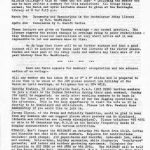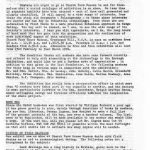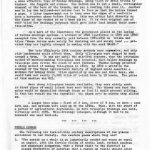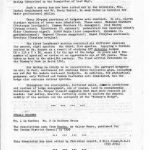Page 1
It is to be regretted that we are still operating under a “State of Emergency” and the Editor urges members to check where it may be necessary on arrangements made for lectures, etc. There was some confusion over the February lecture, unfortunately and several people missed Malcolm Colledge’s talk on “Rome and the East” — including the member who was to have written a summary for this Newsletter! All things being normal, the March and April lectures should be given at The Burroughs Library at 8.00 for 8.15p.m.
5 March — Documents and Manuscripts in the Westminster Abbey Library by N. H. McMichael.
2 April – Verulamium by D. Gareth Davies.
These lectures are given on Tuesday evenings — normal practice. The Library regret the recent changes in evenings owing to power restrictions — they themselves received instructions at very short notice and it was impossible to let our members know in time.
We do hope that there will be no further mishaps and that a good turnout will be achieved for these last two lectures of the winter season. Hendon was once part of the Abbey lands and members may learn more of its past history from Mr Mcmichael.
Here are three appeals for members’ co-operation and one advance notice of an outing: —
Will any member who has taken 35 mm or 2″ x 2″ slides and is prepared to allow them to be shown at the AGM please contact Liz Holliday at the March or April meetings, or telephone her.
Dorothy Newbury invites members to join a visit to the Fulham Potteries during their open weekend. Sunday 7 April is suggested; an early start enabling members to be back in time for lunch, and also to join in any of digging operations in the afternoon. This is the only opportunity to visit the site as it is shortly to be demolished and obliterated. Please let Mrs. Newbury know immediately if you would like to join him.
Jeremy Clynes, of the Press and Publicity Committee, would be glad to hear from any members who can suggest places where posters can be displayed. (Schools and libraries are already circularised.) Please telephone or write to Jeremy as the Society frequently needs to display announcement of its various activities.
FINALLY, don’t forget the MINIMART on Saturday 9 March from 10.00-12.00. Coffee and biscuits and chat with other members. Requests for contributions includes: — used stamps; old paper-backs and records; home-made jam, cakes and scones; bric-a-brac, holiday souvenirs, white elephants; “nearly new” garments; and indoor and outdoor gardening specimens. Telephone for collection. The MINIMART will be held at the Henry Burden Hall, Edgerton Gardens, NW4 (opposite the Town Hall) from 10.00a.m.-12.00p.m..
There will be a meeting of the INDUSTRIAL ARCHAEOLOGY section on 15 March 1974 at 166 STATION ROAD, Hendon, NW4. Please contact Alec Jeakins for further information if required, otherwise turn up at 8.00. During the meeting a short film — Finchley Yesterday’s by Wilf Walters — will be shown. All Society members will be welcome.
Page 2
Archaeology in the Borough
Finally the Editor announces with great pride that the Archaeology in the Borough Exhibition is now open. Having acted as a steward for 2 1/2 hours on the opening day, it was rewarding to hear so many members of the public expressing satisfaction with the display. There is a very real interest in local history and many enjoy relating the excavating activities of the Society to their own environment, so that they go back home determined to be more alert when they are digging in the garden!
Members are urged to go to Church Farm Museum to see for themselves what a varied catalogue of activities is on show. No less than fifteen separate exhibits have been mounted — each of them well presented and clearly identified. It will appeal to a wide range of interests, from those who study old documents –Paleaography — to those whose interests are nearer our own day in Industrial Archaeology; from those who are enthralled and by Flint Tools to a more practical botanical approach in Hedge Dating. You may well be amazed, as I was, to see the wide range of the Society’s interests. I hope you will appreciate, as I do, the long hours of hard work that have gone into the preparation and the realisation of each individual aspect of this exhibition.
Church Farm House Museum, Greyhound Hill, NW4 is open on weekdays from 10.00a.m.-12.30p.m. and 1.30p.m.-5.30p.m., Tuesdays 10.00a.m.-1.00p.m. and Sundays from to 2.30p.m. to 6.00p.m. Admission is free and this exhibition will last from 23 February – 31 March, 1974.
The Committee thanks all members who have come forward recently and offered help with stewarding at the Archaeology in the Borough Exhibition, and would like to add a further note of appreciation, in addition to that given in the last newsletter, to the following members for their help in various ways in connection with the exhibition: — Mr & Mrs Corlet, Mrs de Launay, John Enderby, Celia Gould, Elizabeth Holliday, Brian Jarman, Mrs Mandelstam, Jean Nairn, Marian Newbury, Anna Smullen, G. F. Thompson, Eric Wookey.
The exhibition has really been a corporative affair in which more than 40 members have taken part in one capacity or another, and the Society is paticularly indebted to its Hon. Secretary, Brigid Grafton Green, whose unflagging energy and tireless efficiency have been the inspiration of whole project.
Book Box
Since the HADAS book-box was first started by Philippa Bernard a year ago it has grown greatly in size, mainly through donations of books by members. Our new Hon. Librarian, George Ingram, has decided to make a full list of the present contents of the box, now over 100 volumes. The list, soon to be duplicated, will be made available to any member who would like a copy. If you want one, will you please let Mr Ingram know if possible within the next fortnight as that will enable him to estimate how many copies will be needed.
History of Field Drainage
One exhibit now on show at Church Farm House Museum deals with field drains as an aid to archaeological dating. The following notes are a background to the subject:
Land drainage has a long history in Britain, going back to the Roman cutting of the Car Dykes in the Fens and the ditches of Romney Marsh. By the late eighteenth and nineteenth centuries, however, most available land had already been reclaimed by surface draining of lakes, marshes and fens. At the same time there came the Industrial Revolution and a steady rise in population. Early statistician Gregory King estimated the population of England and Wales at 5 1/2 million in 1700. By the first Census in 1801 it was 9,000,000 and by 1851 almost 18,000,000.
The problem was how to provide food for all these people, using only the same amount of agricultural land as before.
Page 3
One solution — there were of course others — was to improve the drainage, and thus the crop-yield, of heavy farmland by underground, or hollow, drainage. This was no new idea. Deep trenching, with faggots, stones, shells or gravel laid at the bottom of the trench, and then the earth by replaced on top, had long been used as a drainage method; such drains, however, did not last long and needed frequent or re-laying.
Towards the end of the eighteenth century a few landowners began to employ a more effective type of although drainage, using tiles or drain bricks to replace the faggots and stones. One method was to cut a small, rectangular channel at the base of the trench, and put a roofing tile over it. Another was to lay two hollowed-out bricks face to face so that the hollow formed a pipe. A later improvement was to turn over the edges of a roof-tile into a horseshoe shape before firing; this was either laid directly on the floor of the trench or on a base plate. It is this original use of roof tiles for drainage purposes which gave later land drains their name: tile-pipes.
As a mark of the importance of the government placed on the laying of hollow drainage systems, a statute of 1826 (confirmed in 1839 and 1840) exempted from the duty normally paid between 1784-1850 on a bricks and tiles “those bricks made solely for draining wet and marshy land — provided they are legibly stamped in making with the word DRAIN.”
The late eighteenth or early nineteenth century methods were expensive, and only rich landowners could afford them. Early tile-pipes were shaped by hand around a drum. It was not until the mid-nineteenth century, when the extrusion method of machine-making tile-pipes was invented, that hollow drainage by tile-pipe came within the reach of most farmers. Thomas Scragg patented a cheaper method of making tile-pipes in 1845; by 1849 a writer in the Journal of the Royal Agricultural Society of England could describe a machine for making drain tiles operated by one man and three boys, who could turn out nearly 11,000 tiles off 1″ bore in ten hours. The price of this machine was £25.
Once cheap tile-pipes became available, they were widely used. At first pipes of small 1″ bore were tried. The theory was that the water would be channelled through these so fast it would prevent silting. In fact the result was the opposite: the pipes were so narrow they silted up.
A large bore pipe — first of 2 in., later of 3 in. or more — came into use, and systems were laid up to the 1890s. Then, with the start of the period of agricultural depression, no more tile-pipe drainage was laid, virtually until 1939. Mole-drainage (cheaper, although it had to be renewed) was used instead.
PUZZLE CORNER
The following are turn-of-this century descriptions of two places well-to our Society. Can readers guess where they are?
1. “The parish as a whole life is so luxuriantly wooded and wears so rural anaspect, with its fertile fields of arable land, verdant meadows and exuberant hedgerows, that a first visit to the district is always productive of surprise that a region so rustic should exist so close to a great city.”
2. “The scenic attractions (of this district) are quite unique, and lovers of nature in her most captivating aspect will find a wealth of beauty in every turning during their walks and drives which carry one to the most breezy highlights of the Metropolis. For many years to come it will be one of the most felicitous rural community beauty spots to be found anywhere within 20 miles of the great Capital.”
(For the answers, see foot of page 4)
Page 4
The Bishop’s Hedge
Contributed by Paddy Musgrove.
The during 1973 newsletter reported that a hedgerow in Lyttleton Playing Fields, Finchley (TQ 262888) had been identified as a remnant of the north-west boundary of the Bishop of London’s ancient “Park of Haringeye”. At the same time it was suggested that a botanical survey of the hedge would enable us to apply Dr. Max Hooper’s method of hedge dating (described in the Newsletter of last May).
Such a survey has now been carried out by two botanists, Mrs. Isabel Cruickshank and Mr Barry Goater, to whom HADAS is indebted for their professional skills.
Three 30 yd stretches of hedgerow were examined. In all, eleven distinct species of tree were identified. These were: Midland Hawthorn (Crataegus laevigata); Common Hawthorn (C. monogyna); Wild Cherry (Prunus avium); Blackthorn (P. spinosa); Pedunculate Oak (Quercus robur); Elder (Sambucus nigra); Field Maple (Acer campestre); Sycamore (A. pseudoplatanus); Dogwood (Cornus sanguinea); Hazel (Corylus avellana); Hornbeam (Carpinus betulus).
The first (southern) stage contained a six different species; the second, eight species; the third, five species. Applying a formula evolved by Dr Hooper as a result of studying 227 dateable hedges, (X = 110 x Y + 30) where X is the age of their age in years and Y the number of species) we arrive at an approximate age of 725 years. This takes us back to the mid thirteenth century. The first written reference to the Bishop’s Park is dated 1241.
Now dating is likely to be conservative. The surveyed hedgerow is not, in fact, continuous but contains three noticeable gaps, including one cut for the Modern and East-West footpath. In addition, for statistical purposes, only Midland and Common Hawthorns were considered, but the hedge also contains various hybrids.
Throughout the countryside, different soils, climatic conditions and customs of hedge management, can of course, lead to considerable variations and Dr Hooper himself suggests that much more research is needed. Our survey, however, certainly seems to confirm the general validity of his methods and the antiquity of the “Bishops Hedge”.
Puzzle Answers
No. 1 is Hendon; No. 2 is Golders Green.
The description comes from of Hendon, by Walter Moore, published for the Hendon District Council in 1908.
This newsletter has been edited by Christina Arnott.




